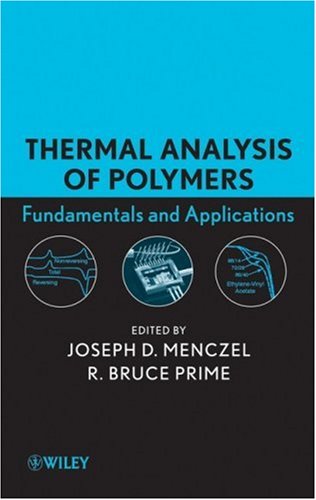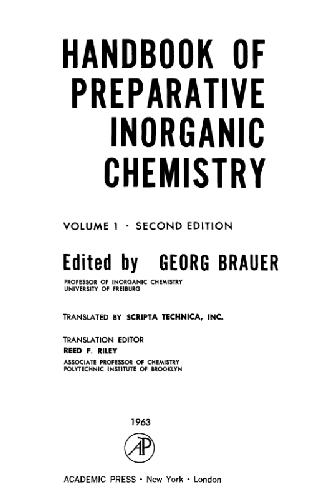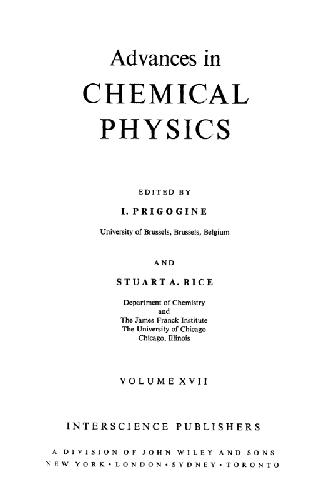Joseph D. Menczel, R. Bruce Prime9780471769170, 0471769177
Table of contents :
Cover Page……Page 1
Title Page……Page 3
2 DIFFERENTIAL SCANNING CALORIMETRY (DSC)……Page 5
5 DYNAMIC MECHANICAL ANALYSIS (DMA)……Page 6
INDEX……Page 7
PREFACE……Page 8
CHAPTER 1 INTRODUCTION……Page 10
2.1. INTRODUCTION……Page 16
2.2. ELEMENTS OF THERMODYNAMICS IN DSC……Page 18
2.2.1. Temperature……Page 19
2.2.2. Heat……Page 20
2.2.3. Enthalpy……Page 22
2.2.4. Entropy……Page 23
2.2.6. Heat Capacity……Page 24
2.2.8. Melting Point and Heat of Fusion……Page 25
2.2.10. Glass Transition Temperature……Page 26
2.3. THE BASICS OF DIFFERENTIAL SCANNING CALORIMETRY……Page 27
2.3.1. Temperature Gradient, Thermal Lag, and Thermal Resistance……Page 28
2.3.2. Heat Flux DSC……Page 30
2.3.3. TA Instruments Modules……Page 31
2.3.4. Mettler Toledo DSC……Page 34
2.3.5. Power Compensation DSC……Page 36
2.3.6. Heating Rate……Page 40
2.3.7. Cooling Rate……Page 41
2.3.9. Purge Gas……Page 42
2.3.10. Encapsulating the Sample……Page 43
2.3.13. Different Types of Differential Scanning Calorimeters……Page 45
2.4. PURITY DETERMINATION OF LOW MOLECULAR MASS COMPOUNDS BY DSC……Page 46
2.5.1. Temperature Calibration of DSC s……Page 50
2.5.4. Miscellaneous Calibrations……Page 59
2.6. MEASUREMENT OF HEAT CAPACITY……Page 61
2.6.1. Measurement of Heat Capacity with Traditional DSC……Page 63
2.7.1. The Glass Transition……Page 67
2.7.2. Crystallization……Page 90
2.7.3. Melting……Page 103
2.8. FIBERS……Page 124
2.8.1. Gel Spun Polyethylene Fibers……Page 126
2.8.2. Isotactic Polypropylene Fibers……Page 128
2.8.3. Polyesters……Page 129
2.8.6. Liquid Crystalline Polymeric Fibers……Page 130
2.9. FILMS……Page 132
2.9.1. Polyethylene Films……Page 133
2.9.3. Nylon 6 Film……Page 135
2.9.4. Poly(vinylidene f uoride) Films……Page 136
2.9.5. Liquid Crystalline Polymer Films……Page 137
2.10. THERMOSETS……Page 139
2.10.1. Measurements……Page 143
2.10.2. Tg – Conversion Relationship and Vitrification……Page 151
2.10.3. Cure Kinetics……Page 153
2.11. DIFFERENTIAL PHOTOCALORIMETRY ( DPC )……Page 163
2.11.1. Background and Basic Principles……Page 164
2.11.2. UV Cure of Free Radical Systems……Page 168
2.11.3. Cationic Photo Polymerization……Page 170
2.12. FAST SCAN DSC……Page 171
2.13.1. Background and Basic Principles……Page 177
2.13.2. Advantages of MTDSC……Page 179
2.13.3. Run Parameters for Thermoplastics……Page 186
2.13.4. Sample Mass……Page 188
2.13.6. Good MTDSC Runs……Page 189
2.13.7. Glass Transition of Amorphous Polymers……Page 193
2.13.8. Crystallization and Related Phenomena……Page 196
2.13.10. Curing and Reactive Systems……Page 201
2.13.11. Use of MDSC for Specif c Thermosets……Page 203
2.13.12. Other Methods……Page 212
2.14. HOW TO PERFORM DSC MEASUREMENTS……Page 217
2.14.1. Sample Preparation……Page 219
2.14.3. Loading the Sample into the DSC……Page 220
2.14.4. Carrying out the Actual DSC Measurements……Page 221
2.14.6. Hardware Considerations……Page 224
2.15. INSTRUMENTATION……Page 226
2.15.1. DSC Resolution and Precision……Page 232
2.15.2. Microbalances……Page 233
Symbols……Page 234
Acronyms……Page 237
REFERENCES……Page 238
3.1. INTRODUCTION……Page 250
3.2.1. The Thermobalance……Page 251
3.2.2. Factors Affecting TGA……Page 252
3.2.3. Controlled Rate TGA……Page 255
3.2.4. Modulated TGA……Page 257
3.2.5. Other Techniques and Measurements……Page 258
3.3.2. Temperature……Page 260
3.4.1. Designing and Performing a TGA Experiment……Page 265
3.4.2. Polymer Thermal and Oxidative Stability……Page 269
3.4.3. Isothermal TGA Experiments……Page 275
3.4.4. Low Molecular Mass Components in Polymers……Page 278
3.4.5. Loss of Volatile Reaction Products……Page 280
3.4.6. Compositional Analyses……Page 283
3.5.1. Overview of Kinetic Principles……Page 286
3.5.2. Kinetic Analyses Based on Isothermal Runs……Page 289
3.5.3. The Flaw of Kinetic Analyses Based on a Single Nonisothermal Run……Page 292
3.5.4. Kinetic Analyses Based on Multiple Nonisothermal Runs……Page 293
3.5.5. Applications……Page 299
3.6.1. Thermal Stability and Lifetime Estimates……Page 304
3.6.2. Permeability of Water and Water Vapor Transport……Page 310
3.6.3. Quantitative Analysis of Ethylene – Vinyl Acetate Copolymers……Page 313
3.6.4. Analysis of Adhesive Blend……Page 315
3.7. INSTRUMENTATION……Page 317
APPENDIX……Page 320
Symbols……Page 321
Acronyms……Page 322
REFERENCES……Page 323
4.1. INTRODUCTION……Page 328
4.2.1. Principles……Page 329
4.2.2. Free Volume Theory……Page 331
4.2.3. Viscoelasticity……Page 333
4.2.4. Physical Quantities Measured by TMA……Page 334
4.3.1. Instrumental Components……Page 335
4.3.2. Modulated Temperature TMA……Page 338
4.4. CALIBRATION……Page 341
4.4.1. Temperature Calibration……Page 343
4.5.1. Preliminary Preparations……Page 344
4.5.3. Sample Requirements……Page 345
4.5.4. Heating and Cooling Rates……Page 346
4.5.5. Sample Preparation and Conditioning……Page 347
4.5.6. Applying the Initial Load to the Sample……Page 348
4.6.1. Glass Transition Temperature, Thermal Expansion, and Melting Temperature……Page 349
4.6.2. Determination of Softening Point……Page 354
4.6.3. Tensile Properties……Page 357
4.6.5. Swelling……Page 363
4.6.6. Curing……Page 365
4.6.7. Viscoelasticity, Creep, and Stress – Relaxation Behavior……Page 366
4.6.8. Plasticizer Ef ciency……Page 368
4.6.9. Service Performance of Polymeric Materials: Lifetime Predictions……Page 369
4.6.10. Determination of Characteristic Parameters, Free Volume, and T*……Page 371
4.7.1. Background on TMA of Films, Fibers, and Composites……Page 372
4.7.2. Measurements on Thin Bonded Films……Page 373
4.7.3. Thermal Cure Shrinkage……Page 375
4.7.4. Photoinitiated Polymerization Shrinkage……Page 376
4.7.5. Compositional Heterogeneity of Polymers: UV Stabilized Polycarbonate……Page 378
4.7.6. Orientation Recovery in a Cable Jacket……Page 379
4.7.7. Adhesion in Dual Coated Optical Fibers……Page 380
4.7.8. Bowing in Integrated Circuit Packages……Page 383
4.7.9. Thermoplastic Composite……Page 384
4.7.10. Glass Reinforced Thermoplastic……Page 386
APPENDIX……Page 387
Acronyms……Page 389
REFERENCES……Page 390
5.1. INTRODUCTION……Page 396
5.1.1. Ideal Elastic Solids……Page 399
5.1.2. Ideal Liquid Behavior……Page 402
5.2.1. Creep Testing……Page 403
5.2.2. Stress Relaxation……Page 404
5.2.3. Dynamic Mechanical Analysis……Page 405
5.3. THE RELATIONSHIP BETWEEN TIME, TEMPERATURE, AND FREQUENCY……Page 410
5.3.1. Time – Temperature Superposition……Page 412
5.4.1. Viscoelastic Transitions or Relaxations……Page 419
5.4.2. Determining Tg by DMA……Page 420
5.4.3. Factors In uencing the Measurement of……Page 423
5.4.4. Secondary Transitions in Amorphous and Crystalline Polymers……Page 432
5.5.1. Effects of Plasticizers and Moisture……Page 433
5.5.2. Impact Behavior……Page 437
5.6. CHARACTERISTICS OF FIBERS AND THIN FILMS……Page 441
5.7.1. The Glass Transition……Page 447
5.7.2. The Extent of Thermoset Cure as Characterized by DMA……Page 449
5.7.3. The Time – Temperature Transformation Cure Diagram……Page 450
5.8.1. Typical Modes of Operation……Page 465
5.8.2. Sample Geometries……Page 467
5.8.3. Frequency Effects……Page 468
5.8.4. Instrument Calibration……Page 469
5.8.5. DMA Test Samples and Testing Mode……Page 474
5.8.6. Temperature – Time/Frequency Analysis……Page 482
5.9. COMMERCIAL DMA INSTRUMENTATION……Page 486
5.9.1. DMA Instruments from Thermal Analysis Vendors……Page 487
5.9.2. DMA Instruments from Other Vendors……Page 492
5.9.3. Rotational Rheometers……Page 495
ASTM Standards Relevant to Dynamic Mechanical Analysis……Page 497
Symbols……Page 498
REFERENCES……Page 500
6.1. INTRODUCTION……Page 506
6.1.2. Information on Surface and Bulk Properties in Con ning Environments……Page 508
6.1.5. Analysis of Nonlinear Electrical and Optical Effects……Page 509
6.1.7. Prelude to the Chapter……Page 510
6.2.1. Frequency – Dependent Response of Dielectrics: Basic Aspects……Page 511
6.2.2. Common Representations of Dielectric Data……Page 514
6.2.3. The Dielectric Relaxation Time τ( T )……Page 519
6.2.4. The Origin of Dielectric Response of Polymeric Materials……Page 521
6.2.5. Attempting Peak Assignments in Dielectric Spectrum of a Polymer……Page 527
6.3.1. Slow Time-Domain Dielectric Spectroscopy: Isothermal Charging/Discharging Currents……Page 529
6.3.2. Dielectric Analysis Based on Lumped Circuit Methods: Frequency Response and Impedance Analysis……Page 530
6.3.3. Dielectric Analysis Based on Distributed Circuit Methods: Coaxial Line Re ectometry and Network Analysis……Page 533
6.3.4. Fast Time-Domain Dielectric Spectroscopy: Time Domain Re ectometry……Page 534
6.3.5. Dielectric Depolarization Spectroscopy: Thermally Stimulated Current Technique……Page 535
6.4.1. Measuring Cells and Sample Preparation……Page 537
6.4.2. Measuring Conditions in AC Dielectric Experiments ( DRS )……Page 542
6.4.3. Typical Measuring Conditions In Global TSC Experiments……Page 545
6.5.1. Thermally Stimulated Current Analysis of Thick PMMA Films……Page 547
6.5.2. DEA Runs with Thick PMMA Films……Page 556
6.6. DIELECTRIC ANALYSIS OF THERMOPLASTICS……Page 562
6.6.1. Simple Nonpolar Polymers……Page 563
6.6.2. Polymers with Flexible Polar Sidegroups Attached to an Apolar Mainchain……Page 565
6.6.3. Polymers with Polar Sidegroups, Rigidly Attached to an Apolar Mainchain……Page 566
6.6.4. Polymers with Polar Mainchain……Page 568
6.6.5. Polymers with Linear Hydrogen Bonded Mainchains……Page 574
6.6.6. Hybrids and Particulate Systems Incorporating Thermoplastics……Page 581
6.6.7. Polymer Blends……Page 582
6.7. DIELECTRIC ANALYSIS OF THERMOSETS……Page 585
6.7.1. Evolution of Relaxation Dynamics during Cure……Page 586
6.7.2. Dielectric Characterization and Monitoring of Cure Process……Page 592
6.7.3. Dielectric Signatures of Water Molecules Con ned in Epoxy Resins……Page 600
6.8. INSTRUMENTATION……Page 601
6.8.1. Dielectric Spectrometers for Measurements in Frequency Domain……Page 602
6.8.2. Dielectric Spectrometers for DC Measurements……Page 607
Symbols……Page 608
Acronyms……Page 611
REFERENCES……Page 612
7.1. INTRODUCTION……Page 624
7.2. THE ATOMIC FORCE MICROSCOPE……Page 625
7.3. SCANNING THERMAL MICROSCOPY……Page 627
7.4. THERMAL PROBE DESIGN AND SPATIAL RESOLUTION……Page 629
7.5. MEASURING THERMAL CONDUCTIVITY AND THERMAL FORCE – DISTANCE CURVES……Page 633
7.6. LOCAL THERMAL ANALYSIS……Page 637
7.7.1. Sample Preparation……Page 642
7.7.3. Calibration……Page 643
7.7.4. The L TA Experiment……Page 645
7.8.2. Photodegradation of Polycarbonate……Page 646
7.8.4. Spatial Resolution of Thermal Nanoprobes……Page 648
7.8.5. Identi cation of Matrix and Occluded Phases in a Polymer Blend……Page 649
7.8.7. Analysis of Biaxially Oriented Polypropoylene Films……Page 651
7.9.1. Local Chemical Analysis……Page 653
7.9.2. Micro/Nano TA Equipment……Page 655
Acronyms……Page 656
REFERENCES……Page 657
A……Page 660
C……Page 662
D……Page 665
E……Page 669
F……Page 670
G……Page 672
H……Page 673
I……Page 674
L……Page 676
M……Page 677
N……Page 680
O……Page 681
P……Page 682
R……Page 686
S……Page 688
T……Page 690
U……Page 695
W……Page 696
X,Y,Z……Page 697
Back Page……Page 698







Reviews
There are no reviews yet.